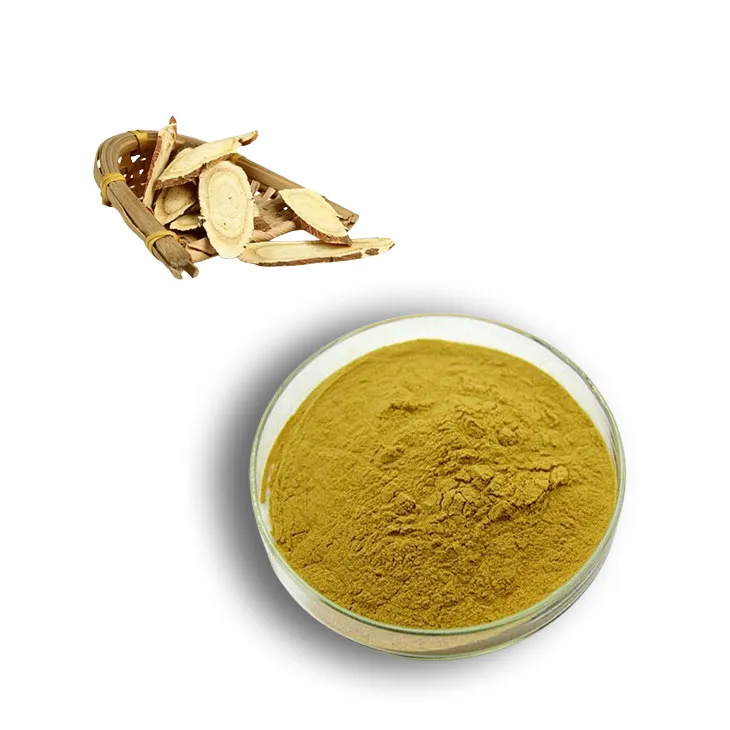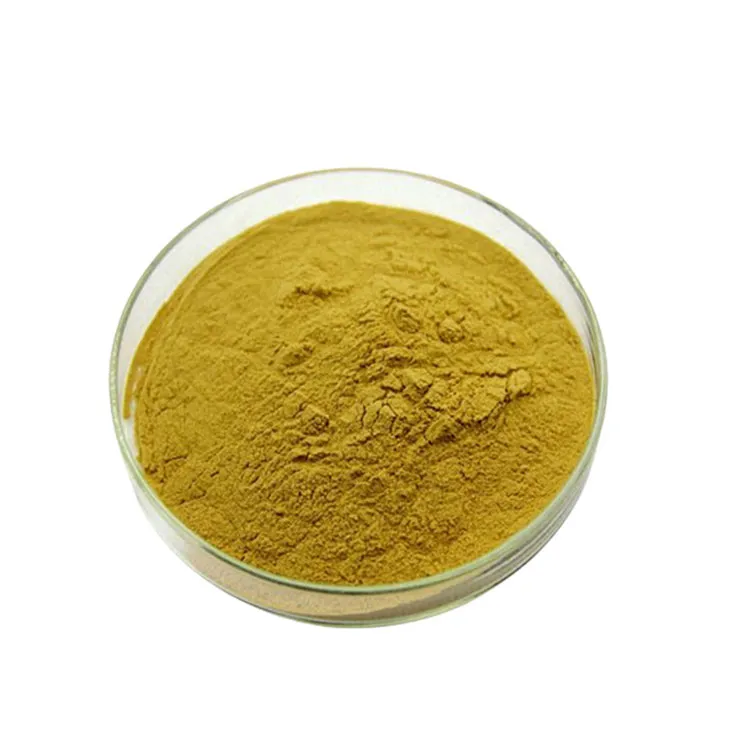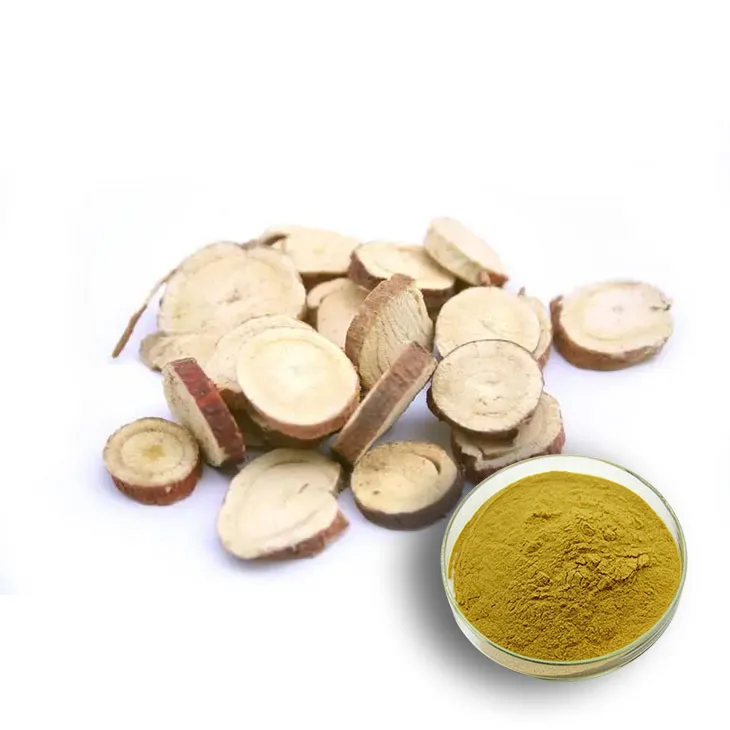- 0086-571-85302990
- sales@greenskybio.com
Licorice Root Extract Powder: Should You Use It for Skin Care?
2024-11-12

1. Introduction
Skincare is a vast and ever - evolving field, with countless natural ingredients being explored for their potential benefits. One such ingredient that has gained significant attention in recent years is glycyrrhiza glabra root extract powder, more commonly known as Licorice Root Extract Powder. This article aims to provide a comprehensive understanding of this extract in the context of skincare, enabling readers to make an informed decision about whether or not to incorporate it into their skincare routines.

2. The Origin of Glycyrrhiza glabra Root
Glycyrrhiza glabra, also known as licorice, is a perennial herb native to parts of Europe and Asia. It has a long history of use in traditional medicine systems across these regions. The root of the glycyrrhiza glabra plant is the part that is typically used for extraction purposes. It is harvested, dried, and then processed to obtain the extract powder. This powder is rich in various bioactive compounds, which are responsible for its potential skincare benefits.

3. Chemical Composition
3.1 Glycyrrhizin
Glycyrrhizin is one of the most well - known components of Licorice Root Extract Powder. It is a triterpene saponin and is responsible for the sweet taste of licorice. In skincare, glycyrrhizin has been shown to have anti - inflammatory properties. It can help soothe irritated skin, reducing redness and swelling. This makes it potentially beneficial for those with sensitive or inflamed skin conditions, such as eczema or rosacea.
3.2 Flavonoids
Licorice Root Extract Powder also contains a variety of flavonoids. These are polyphenolic compounds that have antioxidant properties. Flavonoids in licorice root extract can scavenge free radicals in the skin. Free radicals are unstable molecules that can damage skin cells, leading to premature aging, wrinkles, and dullness. By neutralizing these free radicals, the flavonoids in licorice root extract may help to maintain the skin's youthful appearance and overall health.
3.3 Glabridin
Glabridin is another important compound found in licorice root extract. It has been studied for its skin - lightening properties. Glabridin can inhibit the production of melanin in the skin. Melanin is the pigment responsible for skin color, and excessive melanin production can lead to hyperpigmentation, such as dark spots and uneven skin tone. Glabridin works by interfering with the tyrosinase enzyme, which is involved in the melanin synthesis pathway. This makes licorice root extract a potential ingredient for those looking to address hyperpigmentation issues.

4. Impact on Different Skin Types
4.1 For Sensitive Skin
As mentioned earlier, the anti - inflammatory properties of glycyrrhizin in licorice root extract powder make it a promising ingredient for sensitive skin. Sensitive skin is prone to redness, itching, and irritation. The soothing effect of licorice root extract can help calm the skin and reduce these symptoms. It can be used in products such as gentle cleansers, moisturizers, or soothing masks designed for sensitive skin types.
4.2 For Oily Skin
While it may seem counterintuitive, licorice root extract can also be beneficial for oily skin. The antioxidant properties of the flavonoids can help protect the skin from environmental damage, which can exacerbate oil production. Additionally, its anti - inflammatory properties can help reduce inflammation associated with clogged pores and acne breakouts in oily skin. However, it is important to note that it should be used in combination with other appropriate ingredients for oily skin, such as salicylic acid or tea tree oil.
4.3 For Dry Skin
Licorice root extract powder can contribute to the hydration of dry skin. Although it is not a direct moisturizer like hyaluronic acid, it can help improve the skin's overall health. By reducing inflammation and protecting against free radicals, it can enhance the skin's natural barrier function. This, in turn, can help the skin retain moisture more effectively. It can be incorporated into dry skin products such as rich creams or serums.

5. Pros of Using Glycyrrhiza glabra Root Extract Powder in Skincare
- Natural and Gentle: It is a natural ingredient, which is appealing to many consumers who prefer to use natural products on their skin. Compared to some synthetic skincare ingredients, it is generally considered to be gentler on the skin, with fewer potential side effects.
- Multi - Functional: As we have seen, it offers multiple benefits, including anti - inflammatory, antioxidant, and skin - lightening properties. This means that it can address several skin concerns simultaneously, making it a cost - effective and convenient ingredient in skincare products.
- Long - Standing Traditional Use: Its use in traditional medicine systems provides some historical evidence of its safety and potential efficacy. While modern scientific research is still ongoing, the long - term use in traditional medicine gives some credibility to its use in skincare.
6. Cons of Using Glycyrrhiza glabra Root Extract Powder in Skincare
- Allergic Reactions: Although it is generally considered safe, some individuals may be allergic to licorice root extract. Allergic reactions can range from mild skin irritation to more severe symptoms, such as hives or difficulty breathing. It is important to perform a patch test before using any product containing this ingredient.
- Interactions with Other Ingredients: Licorice root extract may interact with certain medications or other skincare ingredients. For example, it may interfere with the absorption or effectiveness of some drugs. It is crucial to consult a healthcare provider or a dermatologist if you are taking medications or using other products that may interact with licorice root extract.
- Variable Quality: The quality of licorice root extract powder can vary depending on factors such as the source of the plant, the extraction method, and the manufacturing process. Low - quality extracts may not provide the expected benefits and may even contain contaminants.
7. How to Incorporate Glycyrrhiza glabra Root Extract Powder into Your Skincare Routine
If you decide to use glycyrrhiza glabra root extract powder in your skincare routine, here are some ways to incorporate it:
- Look for products that contain licorice root extract as an ingredient. These can include cleansers, toners, moisturizers, serums, and masks. Read the product labels carefully to ensure that the extract is present in a sufficient concentration to potentially provide benefits.
- If you are making your own skincare products at home, you can purchase licorice root extract powder from a reliable source and add it to your formulations. However, be sure to follow proper safety and hygiene procedures when doing so.
- Start with a small amount or a low - concentration product, especially if you have sensitive skin or are new to using this ingredient. This allows you to test for any potential allergic reactions or adverse effects.
8. Conclusion
In conclusion, glycyrrhiza glabra root extract powder has the potential to be a valuable addition to a skincare routine. It offers a range of benefits, from anti - inflammation and antioxidant protection to skin - lightening effects. However, like any skincare ingredient, it also has its drawbacks, such as the potential for allergic reactions and interactions with other substances. By understanding its origin, chemical composition, and impact on different skin types, as well as weighing the pros and cons, you can make an informed decision about whether or not to use licorice root extract powder for your skincare needs. Whether you choose to use it or not, it is always important to maintain a healthy skincare routine that includes proper cleansing, moisturizing, and sun protection.
FAQ:
What is licorice root extract powder?
Licorice root extract powder is derived from the root of the Glycyrrhiza glabra plant. It contains various active compounds such as glycyrrhizin, flavonoids, and isoflavones. These components contribute to its potential effects in skincare.
What are the benefits of licorice root extract powder for skin?
It has several potential benefits. It may help soothe irritated skin due to its anti - inflammatory properties. It can also be used for brightening the skin as it may inhibit melanin production, which is beneficial for reducing hyperpigmentation. Additionally, it has antioxidant properties that can protect the skin from free - radical damage.
Are there any side effects of using licorice root extract powder on the skin?
While generally considered safe for most people, some individuals may experience allergic reactions. Also, if used in high concentrations or for extended periods without proper dilution, it might cause skin irritation. It's important to do a patch test before using it more widely on the skin.
Can licorice root extract powder be used on all skin types?
It is often suitable for a variety of skin types. For sensitive skin, its anti - inflammatory properties can be soothing. Dry skin may benefit from its moisturizing and soothing effects. However, those with very oily skin should use it with caution as it may not be as effective in controlling oil production compared to other ingredients specifically designed for oily skin.
How should licorice root extract powder be used in skincare?
It can be used in various forms such as in creams, serums, or masks. If using the powder form, it should be properly diluted and mixed with other suitable skincare ingredients. It is typically applied topically to the skin after cleansing and toning, following the instructions provided with the specific skincare product containing it.
Related literature
- The Role of Licorice Root Extract in Cosmetics"
- "Beneficial Effects of Glycyrrhiza glabra Root Extract in Skin Health"
- "Safety and Efficacy of Licorice - based Skincare Products"
- ▶ Hesperidin
- ▶ citrus bioflavonoids
- ▶ plant extract
- ▶ lycopene
- ▶ Diosmin
- ▶ Grape seed extract
- ▶ Sea buckthorn Juice Powder
- ▶ Beetroot powder
- ▶ Hops Extract
- ▶ Artichoke Extract
- ▶ Reishi mushroom extract
- ▶ Astaxanthin
- ▶ Green Tea Extract
- ▶ Curcumin Extract
- ▶ Horse Chestnut Extract
- ▶ Other Problems
- ▶ Boswellia Serrata Extract
- ▶ Resveratrol Extract
- ▶ Marigold Extract
- ▶ Grape Leaf Extract
- ▶ blog3
- ▶ blog4
- ▶ blog5
-
Organic Tongkat Ali extract powder factory.
2024-11-12
-
How to make powder with ashwagandha extract.
2024-11-12
-
Rosehip extract manufacturers from China.
2024-11-12
-
The best cat's claw extract in nature.
2024-11-12
-
Chinese Dandelion Leaf Extract Suppliers.
2024-11-12
-
Beetroot juice Powder
2024-11-12
-
Nettle Root Extract
2024-11-12
-
Genistein
2024-11-12
-
Shikone Extract
2024-11-12
-
Black Rice Extract
2024-11-12
-
Shikonin
2024-11-12
-
Beta Carotene
2024-11-12
-
Lavender Extract
2024-11-12
-
Alisma Extract
2024-11-12
-
Panax Ginseng Leaf Extract
2024-11-12





















